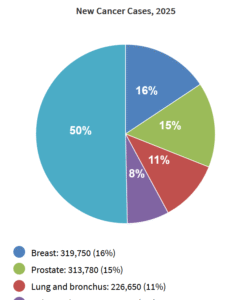 The Breast of the Matter
The Breast of the Matter
When we think about the breast, most people think of the thing(s) most known to us – the female mammary glands. While the word has been used to mean many things throughout time, it usually refers to the closeness of a woman, be it mother or lover. We dwell in the bosom of love, tenderness, or care of a lover or mother throughout our whole lives. It is thought of as maternal, giving nourishment to babies, joy to lovers, or comfort when held near. Is it any wonder that when we hear a woman has breast cancer, we mourn a loss? We mourn the loss of something we consider dear, or at least the physical representation of it. It is that feeling of loss that fills us with sorrow.
But women are not the only ones with breasts, and not the only ones who get breast cancer. Men account for about 1% of all breast cancer cases reported. While it is a small number, it is not zero. However, being such a small number, it is no wonder that the yearly breast cancer awareness focuses on women. Approximately half of all breast cancer patients have no other risks other than being female and of a certain age. In 2022, breast cancer was the most common cancer for women in nearly all countries worldwide (World Health Organization).
 Awareness History of Breast Cancer
Awareness History of Breast Cancer
Before the 1970’s breast cancer wasn’t really spoken about. People just didn’t talk in polite conversations about such intimate and personal issues as life-threatening illnesses. It was a very different time. So what changed? A high-profile person, in this case, the then first lady Betty Ford, came down with the disease and decided to go public with it. On September 30th, 1974, Better Ford underwent a mastectomy and launched public awareness of it, with a little help (Betty Ford).
Throughout the years, the awareness campaign for breast cancer has gone from a week to a month, and has spread reach. With the invention of social media and memes, it is easier today than it ever has been to spread awareness through social media on any topic. But does awareness lead to action?
Is cyberactivism effective?
A study of the effectiveness of social media campaigns on breast cancer memes found that through lighthearted memes meant to grab attention, such as posting your name and the color of your bra, people wanted to reach out and ask questions. With private communication combined with public memes, the awareness of breast cancer is easily shareable, easily digested, and easy for it to go viral when people feel like they are doing something. This cyberactivism has its purpose. It draws people in to ask questions, connects those with commonalities, and spreads awareness of the issue. The memes worked well in diffusing the message the campaign wanted out there, it was fun for people to take ownership of it, and drew people to want to participate.
But is awareness enough?
If simply spreading awareness of an issue, such as breast cancer, is your goal, social media campaigns are a fantastic way to do so. But other than making people aware, is this type of social media campaign able to create actual, physical activism? The Susan G Komen Foundation reported an increase in interest and donations following such viral memes, though no direct correlation can be shown for the increase in donations.
The memes do show, through how many people participate, the rise in interest in the topic when a viral meme is shared. It seems clear that if awareness is the issue, this type of social media marketing works well. And if it does this good for breast cancer, why not aim it at other cancers, such as prostate cancer? Sure, there is the “Movember” campaign, though it is largely the same every year. Every year in November, men (and some women) stop shaving in support of prostate cancer awareness. However, Movember is not met with the same enthusiasm as the memes for October’s breast cancer awareness. The memes for breast cancer awareness are hitting a viral awareness that Movember does not, but why? This would be worthy of a study of its own.

*Nearly as many men get prostate cancer as people get breast cancer. In 2020, 30% of women who had cancer had breast cancer, and 20% of men who had cancer had prostate cancer. Both of these cancers are behind lung cancer in mortality rate; they come in second with 15% of all cancer-related deaths for women being breast cancer, and 10% of men from prostate cancer (National Cancer Institute).
References
Betty Ford and the press conference that changed oncology (2021). The Cancer Letter, 47(25) https://cancerletter.com/in-the-archives/20210625_7/
Mahoney, L. M., & Tang, T. (2017). Strategic Social Media: From Marketing to Social Change. John Wiley & Sons Ltd.
National Cancer Institute. Seer Cancer Database. National Cancer Institute. https://seer.cancer.gov/statfacts/html/breast.html
Alyssa Galganov. (2020, November 2). Breast and Prostate Cancers are the Second Leading Cause of Cancer-Related Deaths Among Men and Women. https://research.utdallas.edu/blog/dr-nikki-delk-is-impacting-cancer
World Health Organization. (2024, March 13). Breast Cancer. https://www.who.int/news-room/fact-sheets/detail/breast-cancer